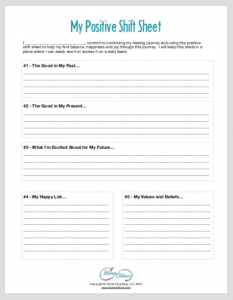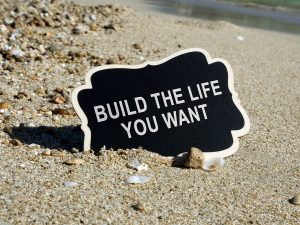
 No matter what type of trauma you’ve experienced, whether physical, verbal, emotional or sexual, and no matter what symptoms you’re still dealing with today, if you’re anything like me, then you REALLY want to heal!
No matter what type of trauma you’ve experienced, whether physical, verbal, emotional or sexual, and no matter what symptoms you’re still dealing with today, if you’re anything like me, then you REALLY want to heal!
And, if you’re like me, sometimes that desire and drive to heal can become all-consuming; a little frantic, a little desperate; simply put, it can take over our lives.
It’s easy to think ‘If I can just fix this one thing, then I’ll be able to move forward with my life,’ or ‘If I can just release this trauma, then I’ll be happy.’
But what I’m going to tell you right now is something you need to hear, and something that I’ve struggled to understand and more importantly, feel as I’ve gone through my own healing journey…
If you’re like me, you may logically understand this, but emotionally your brain may be constantly searching for how release your trauma and heal, especially if you’ve gone down the path of self-help and therapy work.
I know this is easier said than done. Because the truth is that, no matter how hard we might try to contain or compartmentalize it, trauma affects all aspects of our lives from our health and well-being, to our relationships, our weight, our finances and so much more.
And because of this, we can sometimes feel like we can’t escape our trauma. Nothing is un-colored by the traumatic lens through which we view our lives. We are constantly bumping into and being bombarded by triggers and reminders.
And so what I’m going to share with you today, is a simple process that can be pivotal in helping you find joy, balance and happiness in your life TODAY as you go through your healing journey.
Remember, the healing journey is about balance. Like exercise, there are days to push ourselves and go deep into healing, and there are days to rest and just be. This exercise will help you to find and create that balance.
So go ahead and download this PDF by right clicking and ‘saving’ here and then we’ll go through this process together.
It will be extremely important for you to fill out and keep this PDF readily available! 🙂
But before we get into that, let me give you some context…
 When we get triggered, when we veer into a downward spiral, it can sometimes spur us on and push us harder in our healing endeavors. This can be good and bad.
When we get triggered, when we veer into a downward spiral, it can sometimes spur us on and push us harder in our healing endeavors. This can be good and bad.
There have been many times when I have found myself going down the proverbial rabbit-hole of healing. Usually it’s because I’m in a dark place, because of something triggering me.
From this dark place, I’ve been known to book double SE sessions, work with a body worker, receive energy work, do Tapping, journal and more, all in the space of a week.
What I am not consciously aware of when I’m down the rabbit hole – when I go into that mental space – is that I’m running my ‘If I can just heal, or fix this one thing, then I’ll be happy’ or ‘I’ll finally feel safe…’ pattern.
Far from making me feel better, or speeding my recovery, my relentless – hit it from all angles – approach has at times actually hampered, slowed and sometimes stopped my healing process altogether – driving me deeper into despair. The very opposite of what I’m striving to achieve!
You see, sometimes when we’re triggered; when our nervous system is in the stress response states of fight, flight or freeze, our pre-frontal cortex is not online. We are not able to make rational choices or decisions about the direction of our healing journey. It can feel like we’re in a blind panic and like we will do anything to just feel better.
But, the more we push and force our healing, the harder it becomes. We stop allowing time for proper integration and absorption and eventually this can lead to stagnation, futility, burn-out and even quitting altogether.
 So the question is, what can we do differently? How can we avoid burn-out? How can we pull ourselves out of a downward spiral? And is it really even possible to take a more balanced approach to our healing journey?
So the question is, what can we do differently? How can we avoid burn-out? How can we pull ourselves out of a downward spiral? And is it really even possible to take a more balanced approach to our healing journey?
The first thing we need to understand is that all humans have an in-built tendency to hone-in on the problems in our lives. Most people run the ‘ostrich with its head in the sand’ pattern of avoiding their problems and doing everything they can stuff down their emotions and feelings, but that of course does not make them go away.
Other people, like you, are courageous and seek out healing, knowing that more is possible for their life. The only challenge with this is that oftentimes we can become overly fixated on our perceived problems and how to ‘fix’ them.
For example, any time my husband and I would run what I call our ‘intimacy pattern’ (more on that in another post) I would spiral into believing it was all my fault, frantically trying to ‘fix myself’ using all those different healing modalities. Desperate to heal my pain and suffering and avoid future suffering too.
In order to avoid burnout, it’s essential, when we are not actively journaling, or tapping, or doing any other kind of healing work, that we be doing everything in our power to bring our brain towards the positive in our lives. Towards what is going well and towards emotions such as empowerment, happiness and joy.
Easier said than done right? The activity we’ll do below, with this PDF, will help you get there.
But first, why is it that we get stuck on the negative? Why do we have the tendency to hone in on the problems in our lives and why is the desire to ‘fix’ these perceived problems so strong and compelling?

We are experts at finding what’s wrong. Long ago, this ‘negativity bias’ was an essential part of the survival and evolution of our species.
In early human history, paying attention to bad, dangerous, and negative threats in the world (like a tiger prowling in the bushes) was truly a matter of life and death.
The more attuned a person was to the dangers and bad things around them, the more likely they were to survive.
Although we no longer need the constant high-alert of our early ancestors in order to survive, the negativity bias is still central in how our brains function and operate.
This Negative bias can be especially strong and challenging for those of us who’ve experienced childhood, developmental trauma or abuse. When faced with threats, danger, punishment, assault, gas-lighting, narcissism and many other forms of abuse, we are all the more likely to fixate on finding what’s wrong in any given situation. The lack of safety and high levels of fear combine to form high levels of stress hormones and hyper-vigilance.
 So how do we go about shifting away from this negative bias and prevent it from taking over our lives? How do we avoid the downward spiral and make it so that we can both heal and not get consumed by our healing journey?
So how do we go about shifting away from this negative bias and prevent it from taking over our lives? How do we avoid the downward spiral and make it so that we can both heal and not get consumed by our healing journey?
We can do this by finding balance between going ‘into the stuff’ in our healing journey, (when we tap, journal or work with a professional) and connecting with the positive emotions such as joy, happiness, excitement and gratitude that allow us to feel empowered and move forward in our lives.
The challenge is that when we’re ‘in the stuff’ it can be really difficult to find or notice anything good. When we’re in the middle of a downward spiral, it’s almost impossible to be resourceful in the moment. This is why I’m inviting you to fill out your ‘Positive Shift Sheet’ today. If you can fill in this sheet and keep it in an easily accessible place, then whenever you’re in need, you can pull it out and look at it. It will help you find and remember the good stuff and get you back to more positive and resourceful emotions whenever the negativity bias is taking over your brain.
That’s not to say that you shouldn’t feel your feelings or be with grief, shame, fear, anger or any other emotion or sensation that you’re feeling. Let me be clear, I think it is essential for your healing that you DO spend as much time as you need processing all of the emotions, memories, sensations and anything else that is present for you. However, for long term healing work to be truly successful, we do need to strike a balance.
When you are Tapping, Tap. When you are journaling, journal. When you are grieving, grieve.
AND you can also take breaks. It’s ok to pause to re-group and re-charge. It’s ok to have trauma AND be happy. It’s ok to feel lonely AND have fun. It’s ok to feel angry AND take a bubble bath. You get my point! 🙂
As you go through this process, remember…
Ready? Let’s go…

Do you long to feel healthier, happier, more whole and more healed? But yet, you fixate on what’s wrong with you and your life. So often people think, ‘I’ll be happy WHEN I’m healed. I’ll be happy WHEN I get that raise, my life can start WHEN.… I’ll find love WHEN…but the truth is that you DO NOT have to wait to he healed to create a better life, a life you love.
The first step in this process is to write down what has gone well in your life in the past.
By beginning to draw our attention away from only focusing on our trauma and what has gone wrong in our life, we can begin to re-build a stronger foundation for the life we want to create today.
If you’ve experienced trauma, it is likely that when you first begin this list, you may struggle to come up with many (if any) good things from back then. But please don’t give up. No matter how tiny, if you keep looking with an open mind, you will find some things.
THINGS I APPRECIATE ABOUT MY PAST (could include things like):
-I made good friends in college and I’m glad I still keep in touch with them.
-I’m so glad I had my kids young because now I get to enjoy my relationship with them as adults
-I was very good at sports as a kid and it taught me a lot about discipline and staying healthy as I get older.
-I liked to paint as a kid and I was pretty good at it. I won an art show when I was 8.
 Focus on what is good in your life right now.
Focus on what is good in your life right now.
Just as you wrote down your list of things you appreciate about your past, repeat the same process, this time for the things that you appreciate about your present life today.
This will build your sense of accomplishment and satisfaction with your life. Yes, there may still be a long way to go and things you need and want to heal, but making this list will become a go-to resource to help you out when you’re in a downward spiral. This list might include things like:
-My body is a healthy weight
-I enjoy my career
-I like my circle of friends and I make an effort to see them often
-I make enough money to travel 3 times a year and that makes me very happy because I love to travel to new places
 Part of the process of pulling ourselves out of a downward spiral is our ability to create a compelling future for ourselves.
Part of the process of pulling ourselves out of a downward spiral is our ability to create a compelling future for ourselves.
If we are feeling hopeless, lost and futile and we can’t think of a single good thing to say about our lives, we are unlikely to be able to get out of a dark place very easily.
When we are depressed and even suicidal, it’s as if we have tunnel vision. Our world retracts and we shrink.
But, when we can open up our imagination and give ourselves permission to begin to dream again, we can begin to counter-balance the negative bias that has been running our lives for so long.
You may have been told (or told yourself) that it’s pointless to dream. That it’s not safe or realistic and that dreams don’t come true. But this is a trauma response. When we can dream, when we can set goals, when we can imagine the life we want and deserve, then we can begin to build our way towards it. There is freedom in this process!
Your future list might look like this:
-Now that my kids are getting older, I’m excited to be able to connect with them as adults
-I’m going to double my income in the next 12 months
-I have a massage booked for next week and I can’t wait to let the tension in my shoulders go
-I’m going to get my body into the best shape of my life in 2020!
Your ‘happy list,’ simply put, is a list of things that make you happy. Maybe for you it’s going for a long walk, or listening to a particular podcast, or reading a great book, or calling a friend. Whatever it is for you, take a moment to notice what things make you happy and write them down.
you happy. Maybe for you it’s going for a long walk, or listening to a particular podcast, or reading a great book, or calling a friend. Whatever it is for you, take a moment to notice what things make you happy and write them down.
Your happy list is about helping you find resources ahead of time (when you are feeling resourceful) so that when you need it, it’s there. Your list might include things like:
-I love dancing around my kitchen while I cook dinner
-I really enjoy coloring mandala coloring books
-I like going swimming
-My favorite place to walk is with my dog in the park by my house
-I love brushing and snuggling with my dog
-I like drinking hot cocoa and herbal tea
-My favorite friend to chat with on the phone is Sue – her number is….
On a side note – if you are feeling depressed, you might want to add a list of support contacts to this section. These contacts are people you can call who will give you the support you need. You might want to include your best friend, your therapist, colleague or other professional. If you are depressed or suicidal, please reach out for support. You matter. The National Suicide Prevention Lifeline is:

It’s not something most people are taught, but learning to recognize and appreciate the good values and beliefs
that we hold; the good things about YOU, is an essential part of pulling ourselves out of a downward spiral.
Even if we’ve been conditioned to think that we’re a terrible, worthless person – perhaps we were told this explicitly or shown this implicitly – it is still possible to find a few good things about ourselves.
Not only does this counteract the negative beliefs we may have unconsciously taken in such as ‘I’m a bad person, I’m not worthy of love, I hate everything about me’ , but it also enables us to begin building a new post-trauma identity for ourselves.
We cannot change what has happened to us. The events will always be the events. But we can change how we feel about ourselves. And as we build a new identity, we will be in a much stronger position to pull ourselves out of a downward spiral.
Your values and belief statements might include things like:
-I am a kind and caring person
-I am a good listener
-I am good at baking
-I am honest
-I am good at keeping appointments and getting to places on time.
Now that you’ve seen the sample ideas I’ve given for each of these 5 steps, it’s time for you to fill out your own (if you haven’t already).
Print out a copy of the pdf here and get writing! 🙂
Please know that this process will never be perfect. You will have ups and downs. Healing is messy and confusing at times. But with these 5 tips and your completed pdf sheet, you are now well equipped to pull yourself out of any downward spiral!
As ever, I’m here for you if you need support, or if you have any questions. Please email me or click here if you’re like to take your healing journey to the next level by setting up a free healing consultation.

I can find myself in your words very good.
Especially the Internet fore most Youtube can be a endless rabbit hole for selfhelp related topics where at the end of the day/decade you have consumed tons of good content but you feel more lost than you already did before.
And its important do hear it from a professional therapists who provides content.
I’m so glad you could relate and found this helpful. ☺️